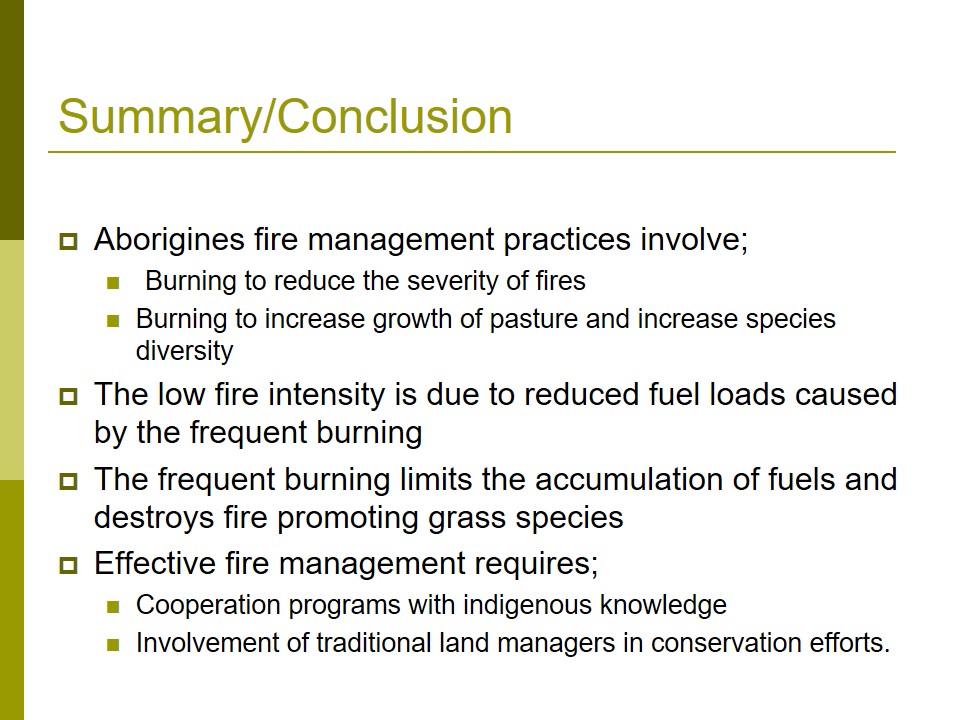Introduction
- Landscape fire management in N. Australia a major challenge;
- Highly flammable vegetation;
- Disappearance of fire-sensitive vegetation;
- Traditionally nomads managed landscape fires.
- High fire incidences due to;
- Aboriginal cultural/land management practices;
- Pastoral practices;
- Lightening strikes.
- Ecology of the area covered by the study i.e. Northern Australia:
- Many fire-sensitive plant species e.g. sandstone heaths;
- Under native Aboriginal occupation;
- Comprises of protected areas such as National parks.
- The study aims to compare Aboriginal fire management practices with other landscape fire management practices.
In Northern Australia, fire management poses a major challenge simply because of availability of inflammable plant species and grasses such as sorghum. These grasses accumulate high levels of fuel loads that enhance the severity of fires. In addition, the loss of fire-sensitive vegetation also contribute to this problem. The Aborigines’ fire management practices involve occasional burning as part of landscape conservation.
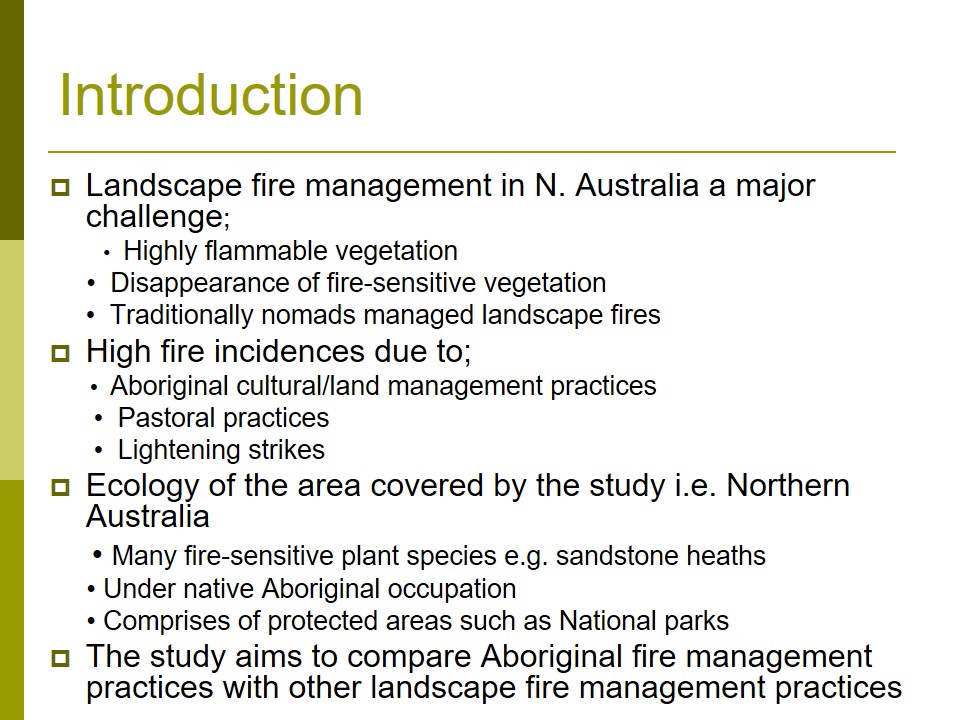
Scope of the study
- Explores sustainable fire management approaches in the region through:
- Ecological assessments;
- Case study on Aboriginal approaches;
- Combined approaches for fire management in the region;
- The geography of the region:
- A plateau area;
- Shrub communities with scattered trees, flammable grasses;
- Seasonal rainfall and high temperatures;
- Fire management practices by the Gunei Aboriginal clan involves spiritual treatment followed by systematic burning.
The study investigates the Aborigines’ practices and compares them with other fire management techniques. To achieve this aim, the study involves evaluation of various aspects of the environment, assessment of the physical geography of the study site, and investigation of the cultural practices of Gunei Aboriginal clan with regard land preparation. The site consists of mainly shrub communities with many flammable grass species. Burning of the land is meant to reduce the flammable substances in these grasses.
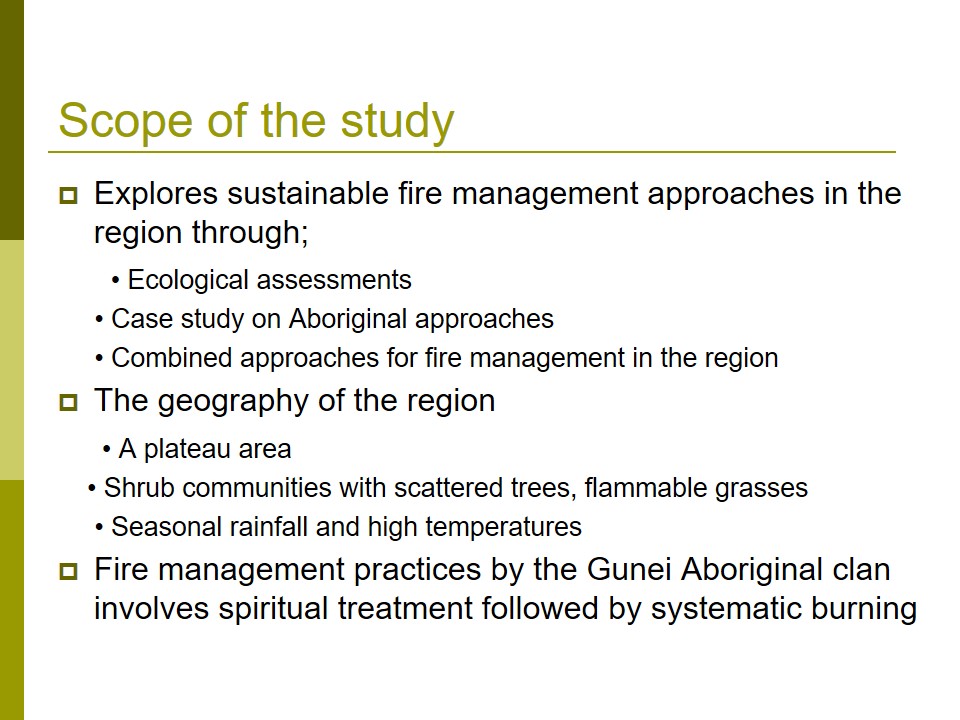
Methods
- Evaluation of the resource base of the region;
- Survey of;
- Fire sensitive vegetation;
- The extent of burning;
- The various habitats within the study region;
- Survey of plant species.
- Ecological assessment of the vegetation sensitive to fire;
- Assessment of the intensity of the fires;
- Interviewing to obtain ethnographic information on traditional fire management practices;
- Estimation of animal population in the region.
In this study, various methods were used. The natural resources of the study site including the plant and animal species were estimated before and after lighting the fires. The extent of burning was also estimated to assess the severity and intensity of the fires. To obtain information regarding traditional fire management practices, interviews were conducted. The presence of flammable vegetation significantly contributed to increased intensity of the fires lit.
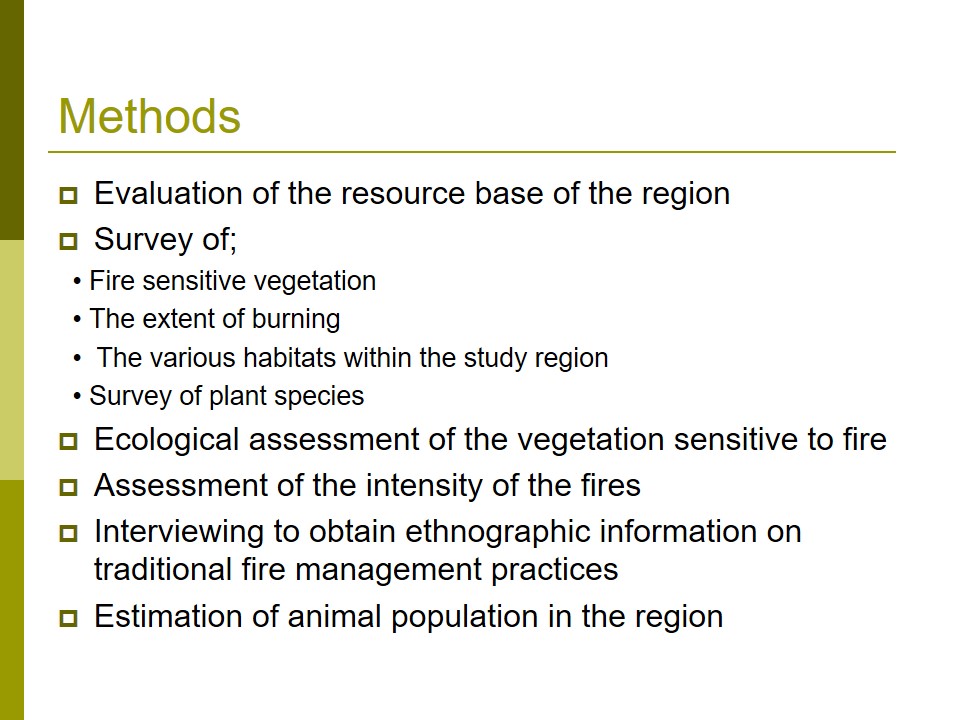
Results
- Survey of the Geographic Resources:
- Canopy height similar in all habitats;
- Species variation between woodland and river flat communities;
- Variation of seeder species in each of the woodland and sandstone habitats (p> 0.05);
- Occurrence of seeders correlated with the slope for woodland habitats and rock cover in sandstone habitats;
- Survey of Animal species:
- Abundant Animal Species; 155 vertebrate species;
- Bird species were dominant comprising of 65% of fauna;
- Most species were habitat-specific.
- Experimental Fire Study:
- nVariation in the proportion of fire-promoting vegetation; coefficient of variation being 72%;
- nLower mass of fuel vegetation resulting to average fire intensities of 7700 kW m-1;
- Aerial Experimental survey:
- nIntensive burning during the dry season; 63.9% of habitats;
- nPopulation of native species remained high especially macropods;
- nHigh population of macropods in recently burned cells.
- Char height was directly related to estimated fire intensity;
- Fire intensity influenced by;
- Wind speed;
- Air temperature.
The study established that the among the vertebrate species, birds were among the abundant species in the burnt sites. In addition, the study found out that most species occurred in one major habitat such as the woodland, sandstone, and riparian habitats. The occurrence of seed producing plant species correlated with the nature of the habitat. Species variation was seen in all the habitats within the study area particularly in woodland and river flat communities.
The study established a variation in fire-promoting vegetation among the habitats within the study area. In addition, in general, the vegetation had a low fuel load due to the Aboriginal fire management practices. As a result, the intensity or severity of the fires were low. The study also established that fire intensity was influenced by environmental factors like wind speed and humidity. Animal species particularly the macropods were abundant in many recently burnt sites indicating a close association of burning and macropod presence.
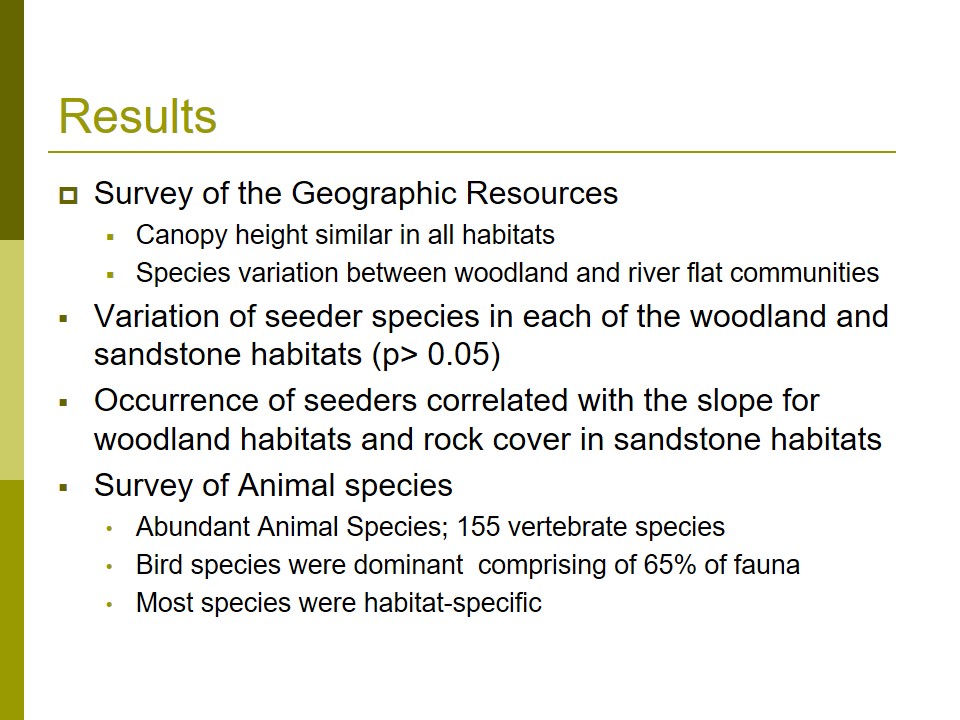
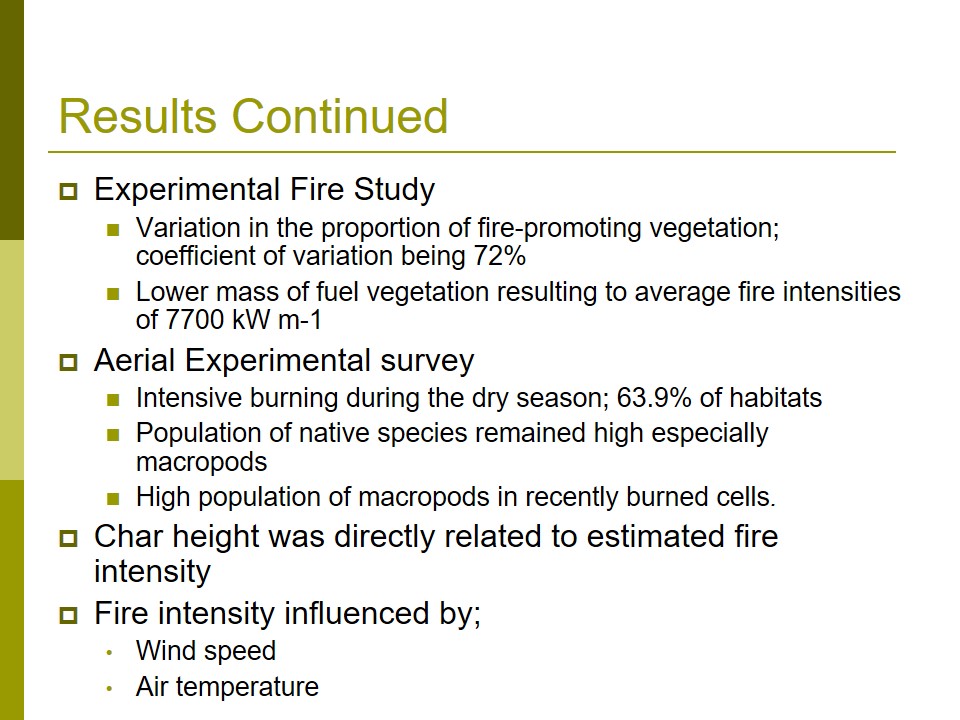
Review & Synthesis of findings
- Native lowland savanna species e.g. native sorghum accumulates high fuel loads;
- Increased frequency of fires due to lightning ignition and intentional lighting;
- Regeneration and re-establishment after fire incidences difficult in the study area with little prospects of recovery;
- Following Aboriginal occupancy, fire promoting vegetation such as native sorghum were absent;
- Extensive fires are of low risk in this landscape due to absence of fire promoting vegetation justifying the Aborigine’s fire management practices;
- The undergrowth plant material in this site support slow burning that cannot damage tall canopies.
Among the important findings of the study is that most native vegetation species accumulate high fuel loads over time that increase fire intensity. The study also found out that regeneration and re-establishment following a fire incident is low. The traditional practices eliminate fire promoting vegetation, which ultimately contributes to reduced severity of subsequent fires. Other than intentional lighting of fires, lightning ignition was identified as a common cause of many fires.
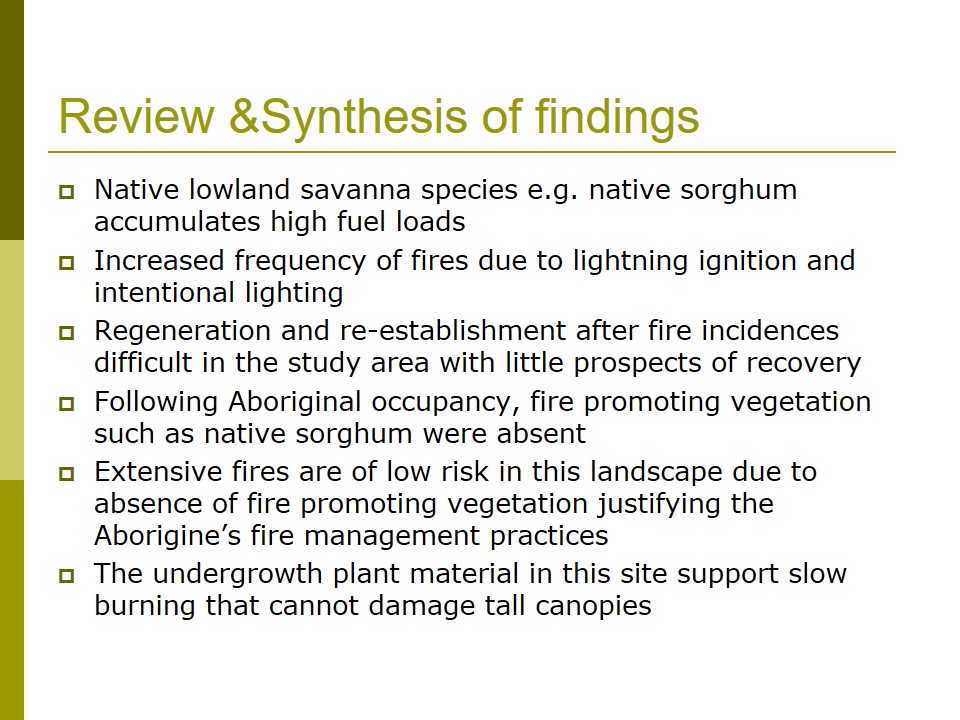
Major Findings
- Fire management in N. Australia:
- Aboriginal fire management practices aim at maintaining ecological integrity;
- Contemporary fire management practices inadequate due to failure to incorporate indigenous practices;
- Maintaining ecological integrity entails;
- Ensuring high biological diversity including vertebrate and plant species;
- In the study site, rare native species considered important to Aborigine land managers were present;
- The populations of exotic plants and animals were low or absent;
- Effective fire management requires the involvement of the Aborigines in conservation.
In particular, the study came up with two important findings. Firstly, the Aboriginal fire management practices reduce fuel loads in certain plant species, which reduces significantly the intensity of subsequent fires. Secondly, the study proposed the incorporation of indigenous practices with contemporary practices and the involvement of Aborigine land managers in order to effectively manage fires in this region.
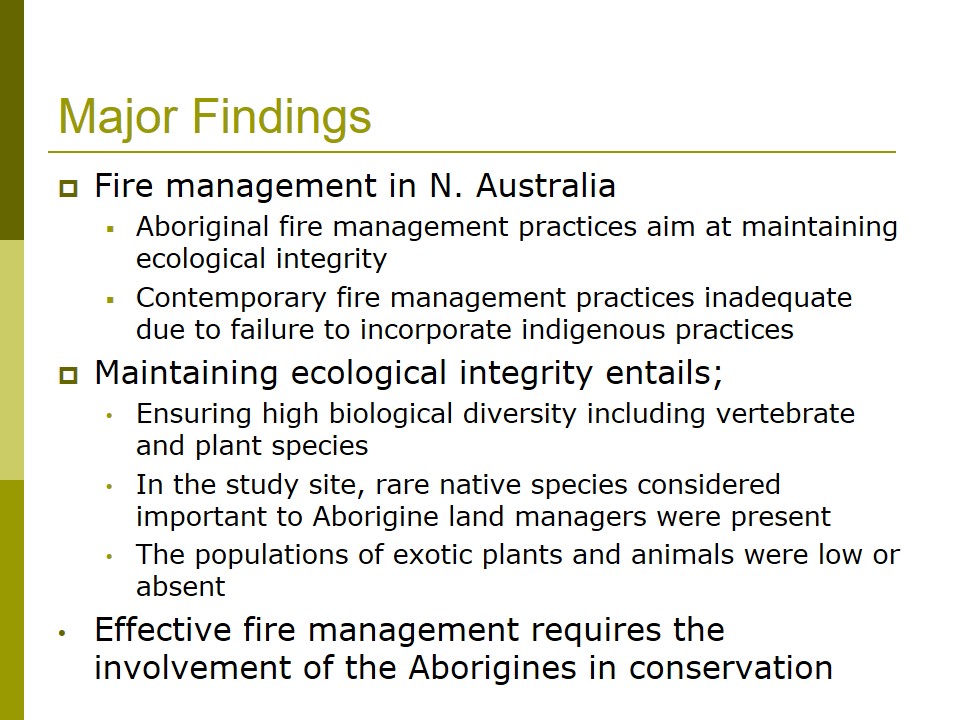
Experimental design
- In the Aerial survey;
- 900 survey cells were constructed;
- Estimation of the population of mammals and macropod groups;
- Estimation of vegetation and tree cover after fire;
- In the fire study;
- Use of quadrants in all three habitats;
- Variables measured;
- Scorch height;
- Char height;
- Fire intensity;
- Determination of vegetation characteristics in unburned quadrants.
- Estimation of woody species in 94 quadrants in the three habitats.
In the study, the experimental design involved aerial survey, fire study, estimation, and correlation of the vegetation species between various habitats within the study area. The site was divided into quadrants or cells and each cell assigned to a given experimental treatment. The variables measured included fire intensity, char height and scorch height. The vegetation characteristics of both the lowly burnt or unburned cell and the severely burnt cells were then compared.
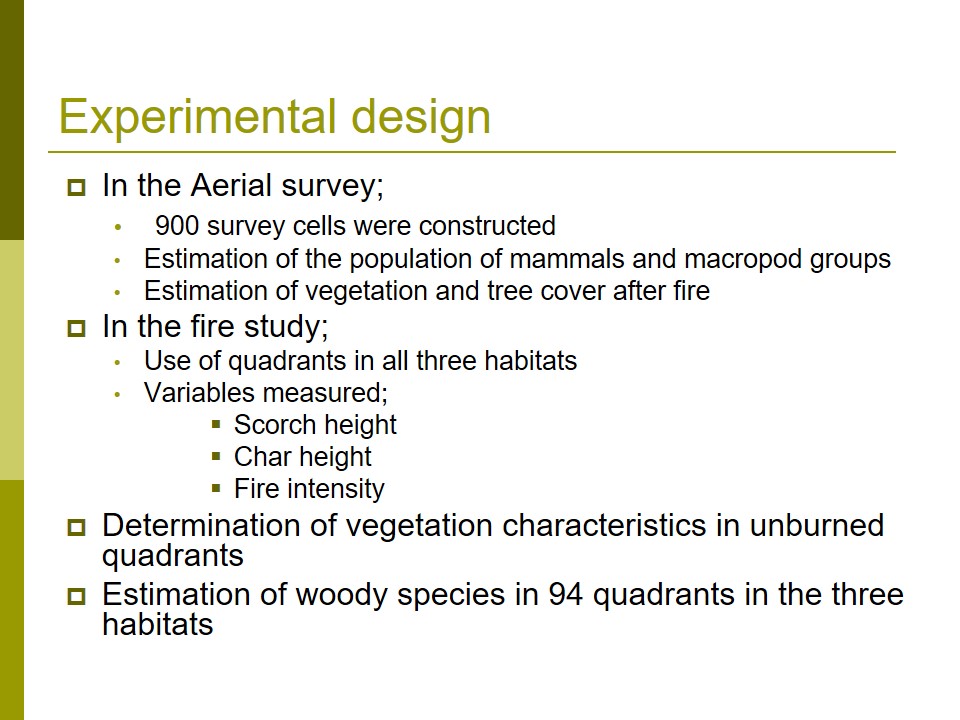
Data analysis
- Chi-square test of association to evaluate the tendency of macropods to occur in burned sites.
- Estimation of animal species density involved use of coefficients of variation.
- The degree of burning was grouped into; nil, low burning and extensive burning.
- Use of correlation analysis in estimating plant species in the habitats.
- Use of mean and range to identify vegetation characteristics in both burnt and unburned sites.
- Mean and range of the fire characteristics and prevalent weather.
- ANOVA in comparing the different habitats.
In analyzing data, a chi-square test was used to evaluate the association between macropods and burnt sites. The population of animals was obtained through estimation in each cell and corrected using the coefficients of variation. The mean and the mean range statistics were used to assess the fire characteristics and vegetation characteristics of the burnt and unburned cells. One way ANOVA was used to compare the various habitats within the region of study.
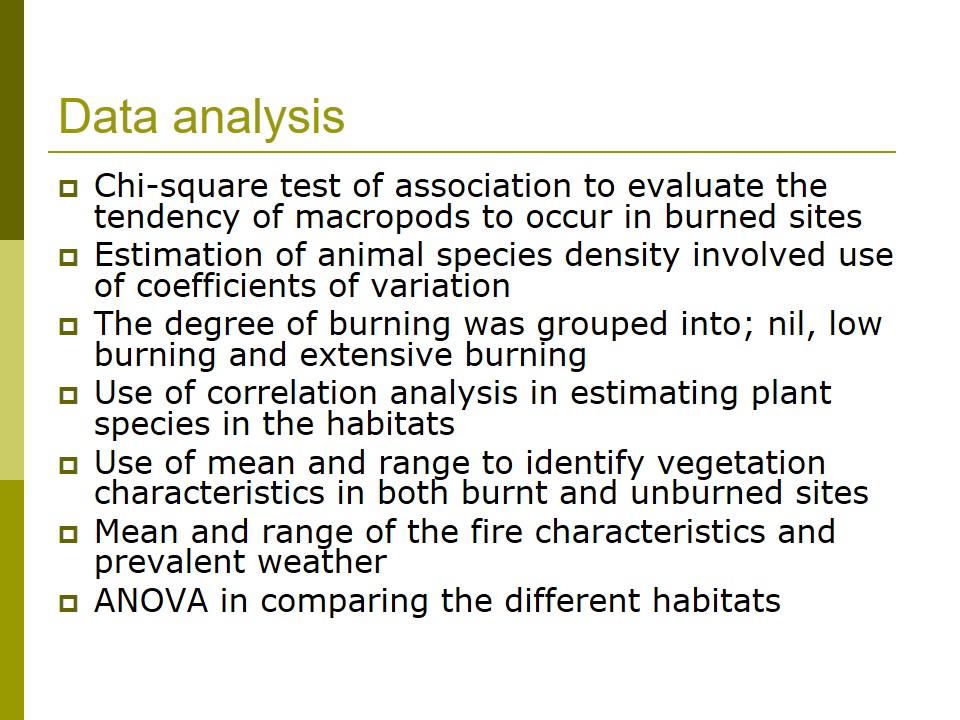
Fire Management Techniques
- The involvement of community in fire management is essential;
- From the study, effective fire management measures agrees with Aboriginal practices;
- The management of traditional lands;
- Importance of indigenous practices;
- My opinion;
- Implementation of fire management technology alongside traditional practices;
- Regulation of the burning practices to avoid extensive habitat destruction;
- The study did not explore the burning practices as a way of reducing fire severity and protecting resources.
From the study, it is apparent that traditional fire management practices are of great significance. In this regard, the implementation of effective fire management practices can only be successful upon involvement of the traditional land managers and practices. The burning plays an important role in reducing the fuel loads in the vegetation hence reducing extensive vegetation destruction during fire incidences. However, the study failed to explore burning as a way of protecting plant resources such as seeds from grazers.
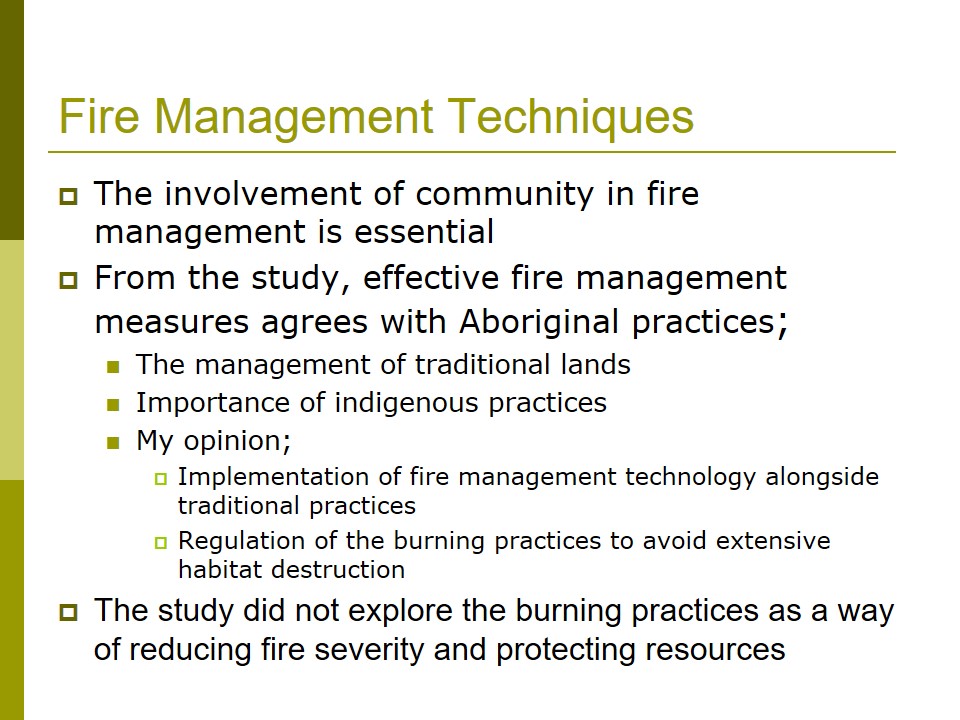
Critical appraisal of the study
- From the study, the reasons for burning include;
- Reduce the severity of fires;
- Reduce fuel roads;
- However, burning can also serve as;
- A away to protect resources;
- Increase visibility during hunting;
- Increase seed dispersal;
- Burning also reduces fuel continuity.
The reasons for burning practices among the Aborigines include the need to reduce fuel loads and in the process minimize fire intensity. However, in my opinion, the occasional burning can serve as a way of enhancing seed dispersal, germination and increasing visibility during hunting or predation. Additionally, burning reduces fuel continuity by destroying plant resources with high fuel loads such as sorghum.
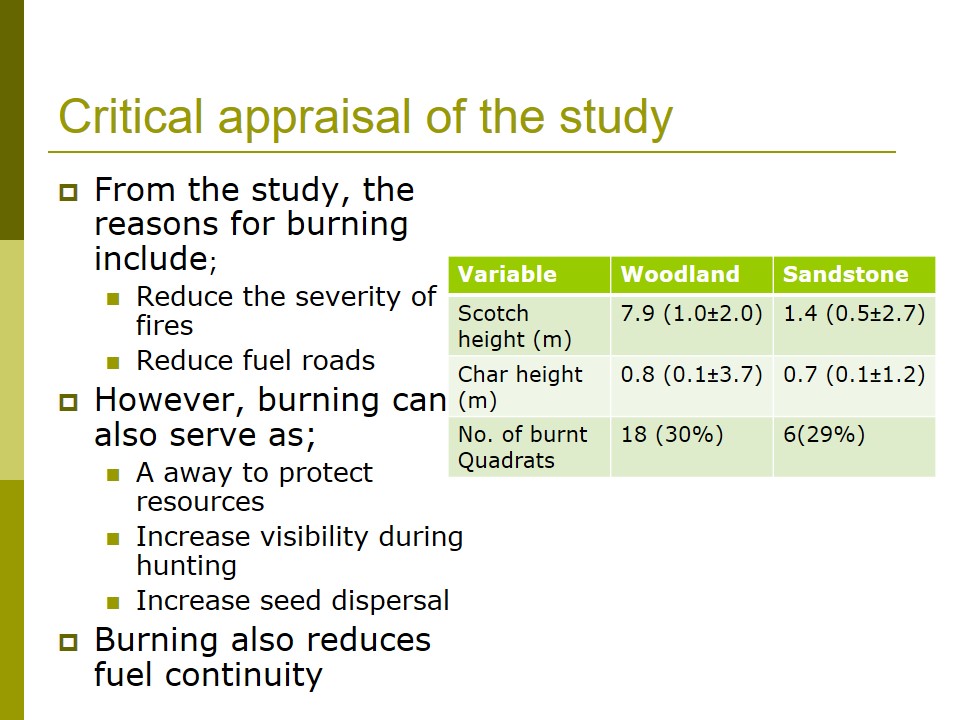
Summary/Conclusion
- Aborigines fire management practices involve;
- Burning to reduce the severity of fires;
- Burning to increase growth of pasture and increase species diversity;
- The low fire intensity is due to reduced fuel loads caused by the frequent burning..
- The frequent burning limits the accumulation of fuels and destroys fire promoting grass species.
- Effective fire management requires;
- Cooperation programs with indigenous knowledge.
- Involvement of traditional land managers in conservation efforts.
In conclusion, the Aborigines fire management practices aim at reducing the severity of fires by gradually eliminating fire promoting vegetation or decreasing the fuel content in these plant species. Therefore, for effective fire management, measures that incorporate indigenous knowledge is essential. Additionally, the involvement of Aboriginal land managers in land conservation efforts is an important strategy towards tackling the problem of frequent fires in Northern Australia. The students and the instructor are likely to ask if, in your opinion, you think frequent burning promotes grass species. They are also likely to ask of your opinion concerning effective fire management.
